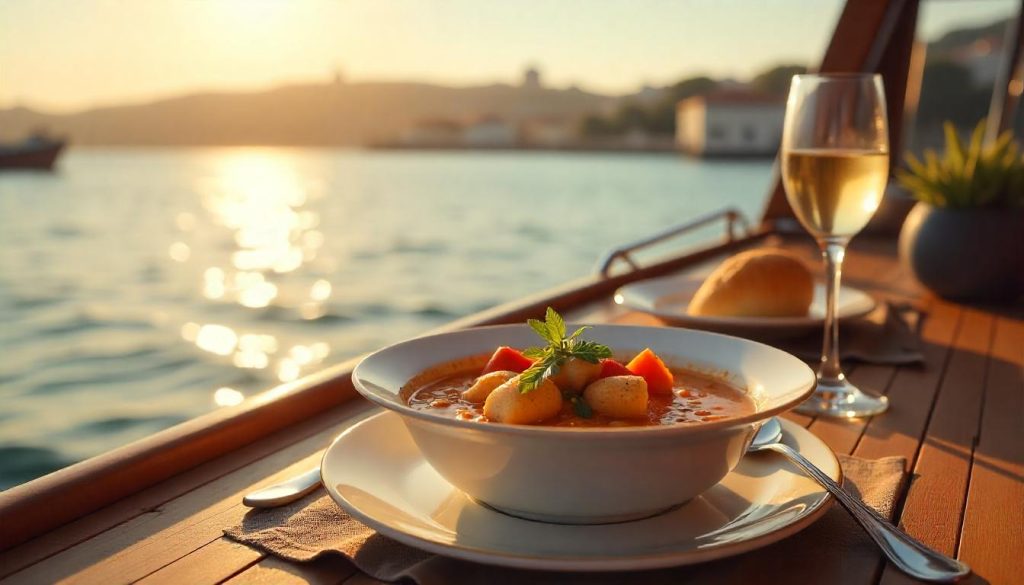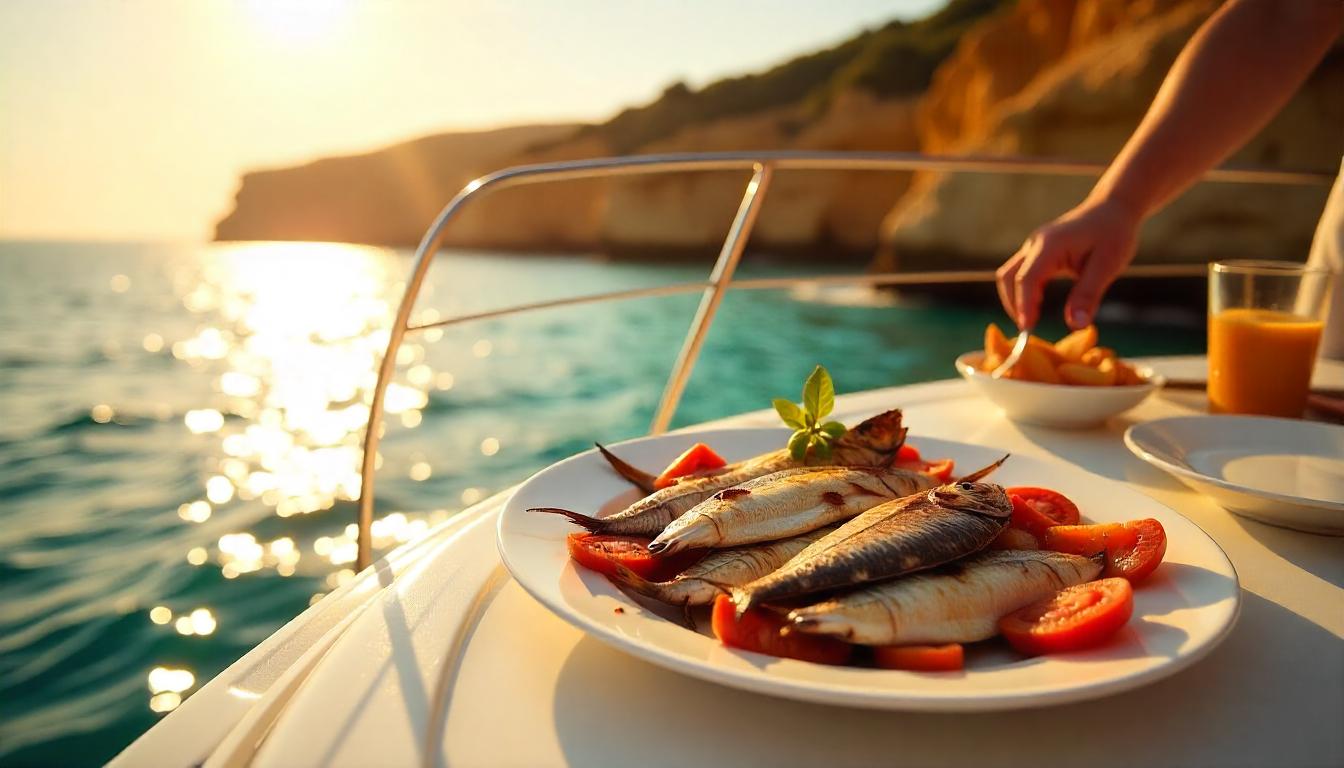Portugal’s rich culinary heritage, rooted in its 1,794 km coastline, makes Portuguese cuisine yacht dining a delightful experience, bringing the flavors of the sea to your vessel in 2025. From the grilled sardines of the Algarve to the hearty caldeirada stews of Porto, yachting along Portugal’s coast offers a unique opportunity to savor authentic dishes while surrounded by stunning ocean views. In this guide, we’ll explore recipes, preparation tips, and coastal dining stops to enhance your Portuguese cuisine yacht experience, ensuring a flavorful journey on the water.
Why Enjoy Portuguese Cuisine Yacht-Style?
Enjoying Portuguese cuisine yacht-style combines the joy of sailing with the country’s vibrant food culture, creating a memorable dining experience at sea. For starters, Portugal’s cuisine is deeply tied to its maritime history—dishes like bacalhau à brás (codfish with eggs) reflect centuries of fishing traditions. Moreover, cooking onboard allows you to use fresh, local ingredients sourced from coastal markets, ensuring authenticity and quality. Consequently, Portuguese cuisine yacht dining appeals to sailors who love food as much as they love the sea, blending culinary arts with nautical adventure.
The Appeal of Portuguese Coastal Flavors
Portuguese coastal flavors are diverse and accessible. For instance, you can buy fresh sardines in Lagos for $4 per kg, grill them onboard, and pair them with a $5 bottle of vinho verde from Porto. Additionally, the cuisine emphasizes simple, fresh ingredients—olive oil, garlic, and parsley are staples, costing $10 for a basic pantry setup. Transitioning to culture, many dishes have regional variations—cataplana in the Algarve uses a clamshell pot, while caldo verde in the north features kale and sausage. Thus, Portuguese cuisine yacht dining offers a taste of Portugal’s regional diversity while sailing its shores.
Grilled Sardines: A Classic for Portuguese Cuisine Yacht Dining
Grilled sardines are a classic dish for Portuguese cuisine yacht dining, capturing the essence of the Algarve’s coastal flavors with minimal effort. To prepare, you’ll need 1 kg of fresh sardines, gutted and cleaned, costing $4 at Lagos’ market, plus olive oil ($5 per liter), garlic, and coarse sea salt ($2 per kg). First, preheat a portable grill—models costing $50 work well on a yacht’s deck. Next, rub the sardines with olive oil, minced garlic, and salt, then grill for 3 minutes per side until the skin is crispy. Serve with boiled potatoes, costing $2 per kg, and a lemon wedge for a zesty finish.
Preparing Grilled Sardines Onboard
Preparing sardines onboard is straightforward. For example, clean the sardines at the market to save time—most vendors in Peniche offer this service for free. Then, set up your grill on a stable surface—use a non-slip mat, costing $5, to prevent sliding on a moving yacht. Transitioning to cooking, keep a fire extinguisher nearby, costing $20, for safety while grilling over an open flame. Also, pair the sardines with a simple salad—lettuce and tomatoes from Faro’s market cost $3, adding freshness to the meal. Therefore, grilled sardines bring the taste of the Algarve to your yacht with ease.
Cataplana de Marisco: A Hearty Portuguese Cuisine Yacht Dish
Cataplana de marisco, a seafood stew from the Algarve, is a hearty dish for Portuguese cuisine yacht dining, perfect for sharing after a day of sailing. You’ll need a cataplana pot, a clamshell-shaped cookware costing $40 online, plus 500g of clams ($5), 500g of shrimp ($8), 1 onion, 2 tomatoes, and a green pepper ($5 total), all available at Olhão’s market. Sauté the onion and pepper in olive oil, add diced tomatoes, a splash of white wine ($5 per bottle), and the seafood, then seal the pot and simmer for 15 minutes. Serve with crusty bread, costing $2 per loaf, to soak up the broth.
Cooking Cataplana Onboard Your Yacht
Cooking cataplana onboard requires some planning. For instance, prep ingredients in port—chop vegetables in Peniche to save space on the yacht’s galley counter. Next, use a portable stove—models costing $30 are safe for onboard cooking, with a stable base for the cataplana pot. Transitioning to timing, cook while anchored—near Praia da Marinha in the Algarve, the calm waters ensure a steady cooking surface. Also, store leftovers in airtight containers, costing $10 for a set, to enjoy the stew the next day. Thus, cataplana de marisco brings a taste of the Algarve to your yacht with rich, communal flavors.
Caldeirada: A Northern Delight for Portuguese Cuisine Yacht Dining
Caldeirada, a fish stew from Porto, is a northern delight for Portuguese cuisine yacht dining, offering a comforting meal with layers of flavor. Gather 1 kg of mixed fish like cod and hake ($10), 2 potatoes, 1 onion, and 2 tomatoes ($5 total), plus garlic, bay leaves, and white wine, all available at Porto’s Mercado do Bolhão. Layer the ingredients in a pot—potatoes at the bottom, then fish, vegetables, and seasonings—add a cup of wine and water, and simmer for 30 minutes. Serve with parsley and a drizzle of olive oil for a hearty dish.
Preparing Caldeirada Onboard in Porto
Preparing caldeirada onboard is simple with the right setup. For example, buy pre-cleaned fish in Porto—vendors at the market charge $1 extra for filleting, saving galley mess. Next, use a deep pot with a lid, costing $20, to keep the stew from spilling on a moving yacht. Transitioning to cooking, anchor off the Douro River mouth near Porto—the calm waters make cooking safer, and the view of the city adds ambiance. Also, pair the stew with vinho verde—a bottle costs $5 and complements the fish’s flavors. Therefore, caldeirada brings Porto’s warmth to your yacht dining experience.
Coastal Dining Stops for Portuguese Cuisine Yacht Adventures
Coastal dining stops enhance your Portuguese cuisine yacht adventures, offering a chance to sample local dishes at port while gathering fresh ingredients. In Lagos, dine at Restaurante O Camilo, a 10-minute walk from Marina de Lagos, where grilled octopus costs $20 per person, with ocean views of Ponta da Piedade. In Lisbon, visit Time Out Market, a 15-minute walk from Marina de Lisboa, where bacalhau à brás costs $15 per person, showcasing the city’s codfish tradition. Transitioning to the Azores, Peter Café Sport in Horta serves lapas grelhadas—grilled limpets—for $12, a local delicacy with marina views.
Sourcing Ingredients Along Portugal’s Coast
Sourcing ingredients along the coast ensures freshness. For instance, Olhão’s market in the Algarve, a 5-minute walk from the anchorage, offers clams and shrimp for cataplana, with vendors providing recipe tips. Next, in Porto, Mercado do Bolhão, a 10-minute walk from Douro Marina, sells cod and potatoes for caldeirada, with organic options at $12 per kg. Transitioning to the Azores, Ponta Delgada’s market on São Miguel, a 10-minute walk from the marina, provides limpets and local cheese for $5 per kg. Also, buy in bulk—herbs like parsley cost $1 per bunch and last a week onboard. Thus, coastal markets enrich your yacht dining with authentic ingredients.

Practical Tips for Portuguese Cuisine Yacht Cooking
A few practical tips can enhance your Portuguese cuisine yacht cooking experience. First, plan meals around your route—buy sardines in Lagos for grilling, then clams in Olhão for cataplana, ensuring variety. Next, use a cooler—models costing $50 keep fish fresh for 2 days, crucial when sailing to remote spots like the Berlengas Islands. Also, conserve water—cleaning fish uses 5 liters, so rinse in port to save onboard supplies, especially in the Azores where freshwater is scarce. Transitioning to safety, secure knives in a holder, costing $10, to prevent accidents in the galley during swells. Therefore, preparation ensures a smooth cooking experience at sea.
Timing Your Culinary Yachting Journey
Timing can elevate your dining experience. For instance, visit Lagos in July during the Sardine Festival—free tastings of grilled sardines align with your onboard cooking, adding a festive vibe. Also, June in Lisbon offers Santos Populares, with street parties serving caldo verde for $5 per bowl, perfect for inspiration. Transitioning to spring, May in Porto brings the Fish Market Festival at Mercado do Bolhão, with discounts on cod at $8 per kg, ideal for caldeirada. Moreover, September in the Algarve provides calm seas and fresh clams, making cataplana cooking easier. Thus, timing your trip aligns with culinary events and fresh ingredients.
The Cost of Portuguese Cuisine Yacht Dining
A 7-day Portuguese cuisine yacht dining trip for four people includes a yacht charter at $3,500, or $875 per person, suitable for coastal sailing. Mooring fees average $65 per night for three nights in Lagos, Lisbon, and Horta, totaling $195, with four nights anchoring for free off Olhão and the Douro River mouth. Fuel for 100 nautical miles costs $200, and ingredients for onboard meals average $15 per person daily, or $420 for four. Coastal dining stops like Time Out Market ($15) total $60 per person. Total: about $4,375 for four, or $1,094 per person.
Budget-Saving Tips for Yacht Dining
Save by anchoring in free spots—staying off Olhão and the Douro River mouth for four nights saves $260 compared to mooring in Lagos or Horta for extra nights. For example, a free anchorage near Praia da Marinha avoids fees entirely. Also, buy in bulk at markets—sardines and clams for four meals cost $20 in Olhão, versus $60 at restaurants, saving $40. Transitioning to dining, opt for street food during festivals—caldo verde in Lisbon costs $5 versus $15 at a restaurant, saving $40 for four. Moreover, use leftovers—caldeirada can be reheated the next day, reducing cooking costs. Thus, smart budgeting keeps your culinary yachting affordable.
Challenges of Portuguese Cuisine Yacht Cooking
Cooking Portuguese cuisine on a yacht can present challenges. First, limited galley space—most yachts have small counters, so prep ingredients in port, like chopping onions in Porto, to save space. Additionally, sourcing fresh fish in remote areas—the Berlengas Islands have no markets, so stock up in Peniche before sailing. Also, cooking during swells—choppy waters near Cascais can make grilling sardines tricky, so anchor in calm spots like Ria Formosa. However, these challenges can be managed with preparation.
Overcoming Yacht Cooking Challenges
Prep in advance—chop vegetables and clean fish in port to maximize galley space, especially in Lisbon before heading to Cascais. For remote areas, pack non-perishables—canned sardines, costing $3 per can, work as a backup in the Berlengas. Transitioning to swells, cook while anchored—Praia da Marinha in the Algarve offers calm waters for safe grilling. Moreover, use a gimbaled stove—models costing $100 keep pots stable during light swells, ensuring safe cooking. Therefore, preparation ensures a smooth Portuguese cuisine yacht experience.
Why Savor Portuguese Cuisine Yacht-Style?
Savoring Portuguese cuisine yacht-style offers a unique way to experience Portugal’s flavors, from the Algarve’s seafood to Porto’s hearty stews, all while surrounded by the sea’s beauty, making every meal a celebration. The blend of fresh ingredients, regional recipes, and coastal dining stops creates a culinary journey like no other. Whether you’re grilling sardines in Lagos or enjoying cataplana off Olhão, Portugal delivers. For a flavorful sailing adventure, this is the way. Therefore, Portuguese cuisine yacht dining is a food lover’s dream at sea.
A Flavorful Yachting Journey in Portugal
Every dish tells a story. For instance, grilling sardines in the Algarve connects you to local traditions. Or, cooking caldeirada off Porto brings northern warmth to your table. This variety ensures a delicious trip. Thus, Portuguese cuisine yacht dining is an adventure you’ll savor.
Final Thoughts on Portuguese Cuisine on a Yacht
Portuguese cuisine on a yacht lets you savor Portugal’s flavors in a unique way, from the simplicity of grilled sardines to the richness of cataplana, with every meal enhanced by the sea’s ambiance. With careful planning, fresh ingredients, and a love for cooking, you’ll create a culinary sailing trip that’s both delicious and unforgettable. So, stock your galley, set sail, and let Portugal’s cuisine delight you—one dish at a time.


